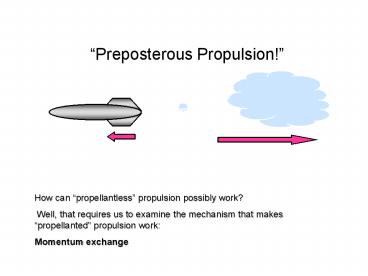Preposterous Propulsion - PowerPoint PPT Presentation
1 / 9
Title:
Preposterous Propulsion
Description:
A rocket essentially exchanges momentum with its propellant. In rocketry, we strive to reduce propellant consumption by increasing the ... – PowerPoint PPT presentation
Number of Views:203
Avg rating:3.0/5.0
Title: Preposterous Propulsion
1
Preposterous Propulsion!
Spacecraft Large Mass Small Velocity Change
Exhausted Propellant Small Mass Large Velocity
Change
How can propellantless propulsion possibly
work? Well, that requires us to examine the
mechanism that makes propellanted propulsion
work Momentum exchange
2
Momentum Exchange
A rocket essentially exchanges momentum with its
propellant. In rocketry, we strive to reduce
propellant consumption by increasing the exhaust
velocity of the propellant (specific impulse).
But whether were exhausting water vapor,
antimatter, or ping-pong balls, the principle is
still the same. And once the propellant has been
exhausted, its mass and momentum disperse and
become unrecoverable.
3
Propellantless Propulsion
- Gravity assist
- exchanges momentum with a planets heliocentric
angular momentum - couples through gravitational interaction
- Solar or laser sailing
- exchanges momentum with photons
- couples through optical reflection
- Magnetospheric plasma propulsion
- exchanges momentum with solar wind ions
- couples through electrodynamic interaction
- Electrodynamic tether propulsion
- exchanges momentum with a planets rotational
angular momentum - couples through electrodynamic interaction with
planetary magnetic field
In order to do away with propellant, different
forms of momentum exchange must be employed.
Hence we must look for other sources of momentum,
and couple to them.
4
Tether Boost Station Functional Diagram
- Advanced Solar Arrays
- thin-film photovoltaic
- rad-hard
- 300 W / kg
- Power Management
- hi-voltage bus
- voltage converters
- Tether Ballast Mass
- comprises 50 of station mass
- empty STS external tanks?
- burnt-out upper stages?
- lunar water?
- asteroidal ore?
- Hi-Strength Hoytether
- Spectra 2000
- embedded w/conductive Al tether
- multi-strand
- survives multiple breaks
- safety factor 3.5
- Plasma Contactors
- field-emitter array cathodes
- bare-wire anodes
- capable of day/night operation
- Flywheel Energy Storage System
- based on GRC ISS units
- magnetic bearings
- 100 Whr / kg
- Payload Catch System
- passively catches payloads
- tolerant of position and velocity errors
- lightweight
- automatically deploys
- shock absorber damps out tether oscillations
- Tether Deployer
- hi-strength spool
- capable of tether reeling
- mounted on shock absorbers
5
Payload and Tether Orbits before and after Catch
Orbital velocity of tether CM 9.2 km/s
Tether tip velocity 1.5 km/s
Payload orbit before catch (equatorial circular)
Orbital velocity of payload 7.7 km/s
Tether/payload orbit after catch
The tether tip velocity is exactly the difference
in orbital velocities between the payload and
tether. They meet together, instantaneously, at
the same position with the same velocity.
Tether orbit before catch (equatorial elliptical)
6
Payload and Tether Orbits before and after Throw
The tether tip velocity is exactly the difference
in orbital velocities between the payload and
tether. They meet together, instantaneously, at
the same position with the same velocity.
Payload orbit after throw
Orbital velocity of payload after throw 10.7 km/s
Orbital velocity of tether CM 9.2 km/s
Tether orbit after throw
Tether/payload orbit before catch
7
Injecting the Payload on an Escape Trajectory
High-energy payload orbit
Payload executes a plane change ?V at apogee to
target correct departure declination. Plane
change ?V is proportional to velocity hence, a
plane change at apogee requires much less ?V than
a manuever at perigee.
Payload executes an injection ?V at perigee to
target correct departure C3.
?V ?(C3 2?/r) - ?(?(2/r - 1/a))
?V 2 V sin(?/2)
8
Electrodynamic Reboost of De-energized Tether
Orbit
Electrons are emitted from cathodes on the tether
endmass. The energy to drive the current comes
from the solar arrays.
Electrons flow upward through insulated portion
of conducting tether and exert a force on the
tether due to its motion through the Earths
magnetic field.
F J x B
Tether orbit before reboost
Electrons are attracted to bare-wire portion of
tether because of its positive bias voltage.
Current is collected.
Tether orbits during reboost
Tether orbit after reboost is complete
9
Momentum-exchange / electrodynamic reboost (MXER)
tether propulsion
Efficient, propellantless propulsion that
performs like a high-thrust rocket































